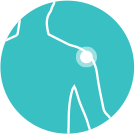Tennis Elbow (Lateral Epicondylitis)
Lateral epicondylitis, more commonly known as tennis elbow, is damage to the extensor tendons (common extensor origin) that are attached to the lateral epicondyle, which is the bony bump on the outer (lateral) side of the elbow joint.
What Causes Tennis Elbow?
In common with the related condition of golfer’s elbow, tennis elbow is an overuse injury which arises from repeated contractions of the muscles in the forearm. This can cause inflammation and micro tears in the tendons. It is the one of the most common causes of pain around the elbow.
Although people who play tennis and racquet sports are at high risk, it can occur in people who play other sports involving grip strength including cricket, baseball or golf. Workers who frequently use heavy tools, perform repetitive lifting or repetitive actions are also at risk of developing the condition.
What are the Signs and Symptoms of Tennis Elbow?
Tennis elbow generally causes pain at the outside of the elbow, which can be felt up and down the arm. It is worse with lifting, gripping or repetitive movements, especially wrist extension (bringing the wrist up like revving a motorbike).
How is Tennis Elbow Diagnosed?
Mr Soong Chua and his team will begin with your medical history and a physical examination to assess your pain and range of movement. They may then move onto imaging tests such as x-rays, ultrasound or an MRI scan.
What are the Treatment Options for Tennis Elbow?
Mr Soong Chua will consider a range of lateral epicondylitis treatment options, including:
- Rest and/or Activity modification – avoiding the aggravating activity
- Splints or braces
- Non-steroidal anti-inflammatory medication (such as ibuprofen)
- Steroid injection– to reduce inflammation
- Physiotherapy – to stretch and strengthen the forearm muscles
- Ultrasound – to increase blood flow and promote healing
Surgical Repair
If non-invasive tennis elbow treatment proves to be ineffective in your situation, Mr Soong Chua may recommend surgery to repair damaged tendons. Surgery is generally considered in patients who have had symptoms for over 6 months and have undergone at least 3 months of physiotherapy, but show little improvement.





